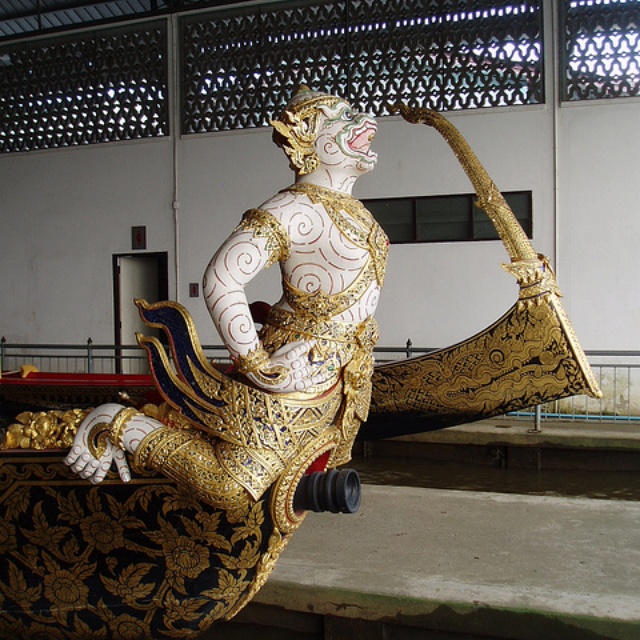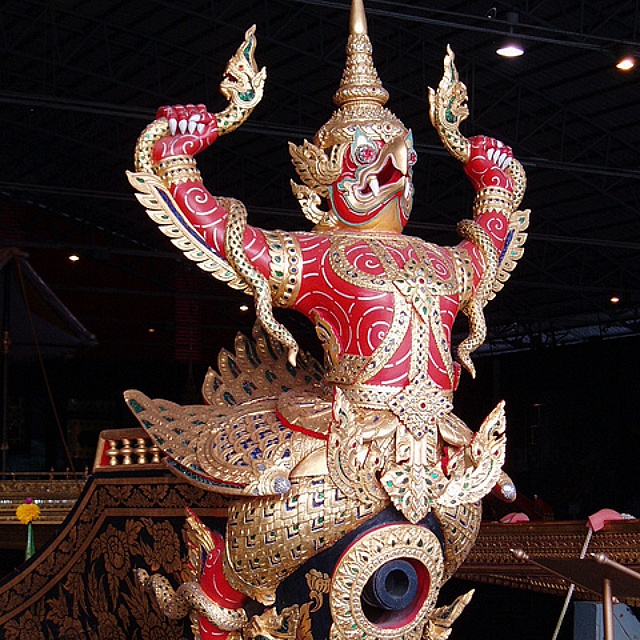
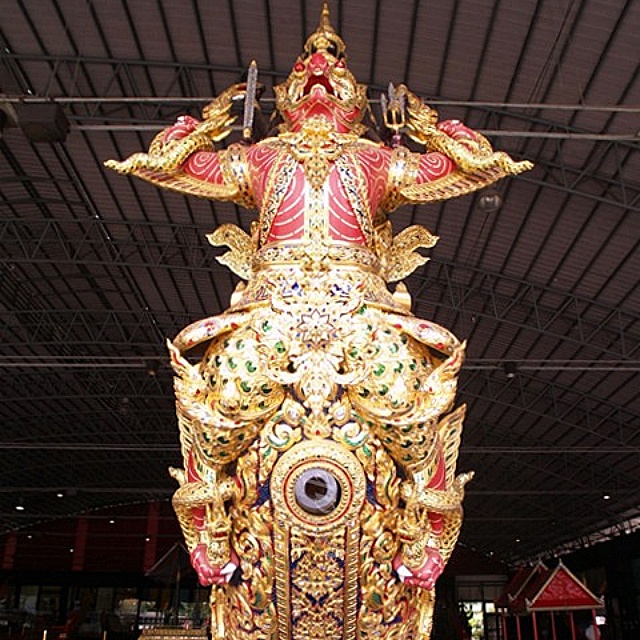
The famous Royal Barge Procession is one of the spectacular grand epic event known Internationally. It is an event that people come from the world over to watch as it does not occur on an annual basis but only by Royal decree and. One such celebrated ceremony is the presentation of monk robes by the King called the “khatin” at the end of the Buddhist Lent period. This ceremony will see the use of fifty two Barges that will ply the Chao Phraya River (also known as The River of Kings) from Khet Dusit also known as Wasukri Royal Landing Place to pass Temple of the Emerald Buddha, Wat Pho and the Grand Palace onto Wat Arun (the Temple of Dawn).
Travelers who visit Bangkok city during their sightseeing holidays sometimes miss this unique little museum near the Chao Phraya waterfront because it can be a little difficult to get too from land to which an alternative would be the nifty little long-tail boats that can bring you close to the museum entrance. Frankly, you wouldn’t want to miss this little Museum on your next trip to Bangkok! The Royal Barge National Museum is a one-of-a-kind museum where the famous Royal Barges are kept when not in use for ceremonial purposes. There is a wonderful collection of Royal Barges some as old as two hundred years during King Rama 1st reign or dating back to the Ayutthaya period when Ayutthaya was still the capital of Siam.
If you wonder what are the Royal Barges, a quick run through of the history of these remarkable Barges is that in the olden days they were used as warships along the Chao Phraya river. The Barges were classified as for use by the King, the Royal family members, escort Barges and warship Barges. These Barges mostly exquisitely carved out of long logs and with very intricate and colorful figureheads could seat about fifty plus rowers and several high ranking naval officers while sporting a single cannon on the front figurehead. The barges were a beautiful blend of intricate Thai arts and craftsmanship.

When you visit the museum you would see the wet and dry docks where these Barges are kept and routinely serviced or reconditioned by master craftsmen. After all, they are not your average Barges and require very skilled artisans to look after them and keep them ready for the next Royal Barge Procession ceremony. There is a section at the back of the Barges where you could sit and watch a video on the history of these Barges so that you will have a better understanding and appreciation for them. Along one side of the wall are memorabilia of the Barges such as the uniforms worn by the different rank of rowers, the types of paddles used and other interesting artifacts.
There are about six wet and dry dock slots in the museum, each one featuring one of the six most famous Barges often used in Royal Ceremonies. Each of these Barges sport intricate sculpted figureheads representing different characters from the Ramayana stories as it is believed that the Barges are the vehicles of the God Rama in the Hindu mythology. The entire length of the Barges are also carved with intricate patterns and the whole Barge is decorated with glimmering pieces of glass and shiny beads. Some of the more important Barges used by the King and Royal family, are inlaid with gold paint and gold leaf pieces as well as semi-precious stones.
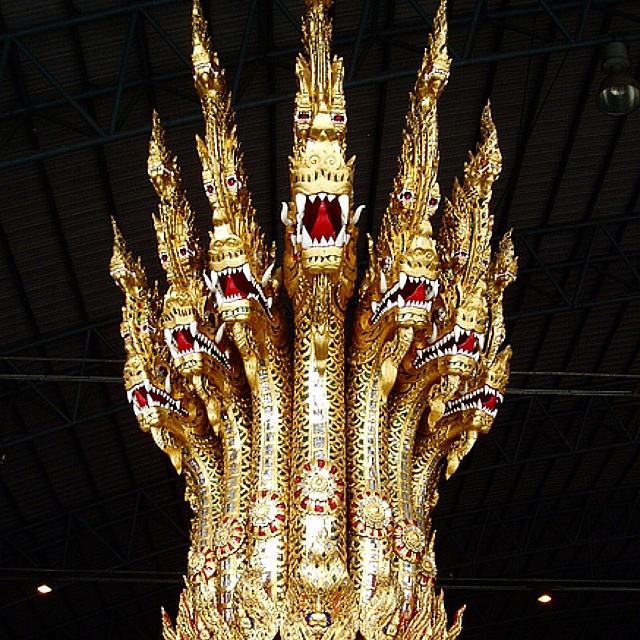
A few of the more famous Royal Barges are on display here at the museum including the very beautiful and first among the ranks of Royal Barges is the “Suphannahong” also sometimes known as “The Phoenix” or “The Golden Swan”. This Royal Barge is recognized by it’s delicate figurehead in the shape of a mythical swan or dragon like figure. Lacquered in gold paint, encrusted with shiny pieces of glass, gold leaf and on ceremonial procession events, decorated with garlands of flowers around her neck and a tasseled crystalline ball hanging from her delicate mouth. Commissioned by King Rama VI and built in 1911, the barge was crafted from a single piece of teak log measuring 46 meters long. The middle of the barge contains a golden Pavilion to house the King and his immediate family during ceremonies. This is the most famous lead barge in the Royal Barge ceremonies, usually rowed by a special elite group of 50 Navy oarsmen with a chanter (the callout instructor), two steersmen, a signal man, standard bearer, seven Royal Insignia bearers, and four officers. In 1992, the Suphannahong was awarded the title of “Maritime World Heritage” by the World Ship Trust.
When you are at the museum, admire her intricate beauty and try to imagine what it would be like to sail with her and a full crew during ceremonies on the amazing River of Kings , the mighty Chao Phraya River. Just having the opportunity to watch the Royal Barge Procession ceremonies will already give you a feel of the pride and power to be on board with the sound of ceremonial drums, chanting and a long procession of other Royal Barges!
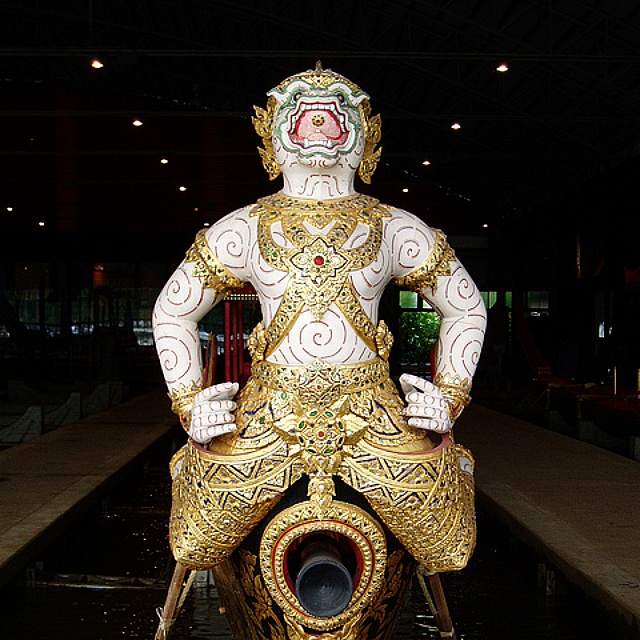
The next most unusual Royal Barge is the “Anantanakkharat” recognizable by the seven serpent heads which befits the meaning of the barge as “King of Serpents”. This is the second built barge after the original “Ananta” which was built by King Rama III and used primarily by King Rama IV. The new Anantanakkharat was built by King Rama VI in 1914 with the current mythical seven-headed serpent on the bow. The entire barge is crafted with numerous entwining serpents and gilded in gold lacquer with a green hull. The neck of the seven serpents are painstakingly carved and painted with fine motifs. Notable is the gilded pagoda-like pavilion which is slightly smaller than that found on other Royal Barges as it is meant to carry holy objects and relics. Each one of these Royal Barges requires very skilled artisans to undertake the creation and finishing on the barges. Imagine how much work that has been put into each of these barges and appreciate the beauty that Thai artisans have in creating some of the most beautiful and intricate of designs.
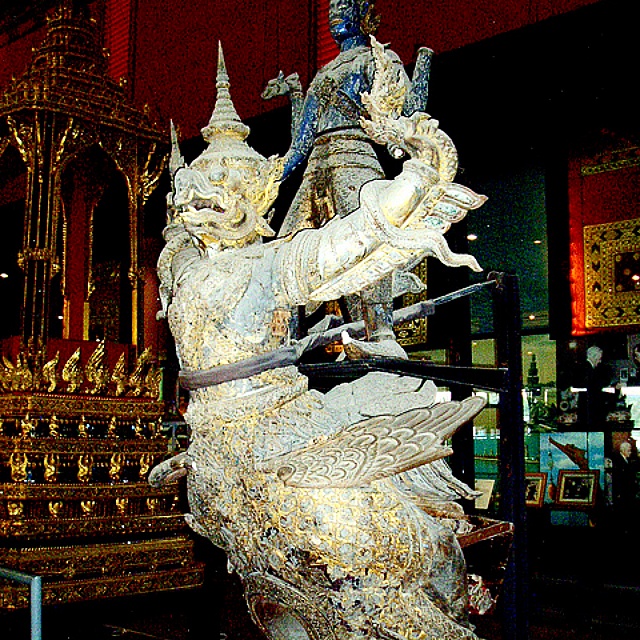
The latest Royal Barge to be commissioned was the Narai Song Suban Ratchakan Thi Kao or better known as Narai Song Suban HM King Rama IX. Translated it means that the God Narayana is on Garuda his carrier. This barge was commission by HM the late King Bhumibol Adulyadej in the year 1994 and built by the Royal Thai Navy with the collaboration of the Thai Department of Fine Arts. It was to commemorate and celebrate the fiftieth year of HM King Bhumibol Adulyadej accession to the throne with a Royal Barge Procession in the year 1996. It was also the only occasion that the Narai Song Suban undertook the lead role in the procession from the Suphannahong.
This particular Royal Barge had an existing figurehead which was the Garuda, a sort of half-human mythical figure with the head of an eagle-like creature holding serpents in his hand. It was originally known as the Mongkul Suban. Later during the reign of King Mongkut, HM had it fitted with the figure of Narayana fitted onto the back of the Garuda and was renamed the Narai Song Suban before it was recommissioned by HM King Bhumibol Adulyadej much later. The hull of the Narai Song Suban is painted red in color for the Royal Barge Procession ceremonies. You can see the original figurehead of the Narai Song Suban of which the rest was destroyed by fire when the docks were bombed by Allied bombers during WW2. A number of other barges were also damaged or destroyed during this time and some of them were beyond salvage.
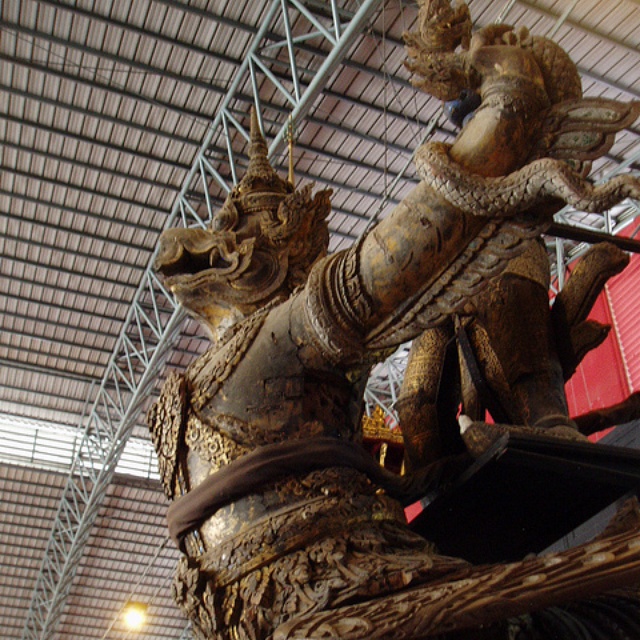
It is interesting to know that the Anekkachatphuchong is the oldest Royal Barge to still sail in the Royal Barge Procession. This particular barge has no visible figurehead and was built during the reign of King Chulalongkorn or Rama V in the 19th century, making it more than two centuries old to date. The name Anekkachatphuchong means Variety of Serpents and even though it has no figurehead, the entire hull is embellished with multiple motives of seven-headed serpents with lacquered gold paint and a hull that is painted in pink.
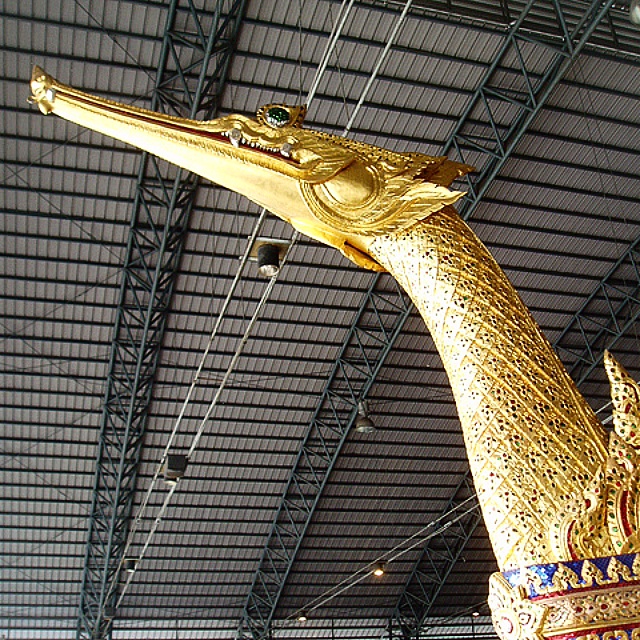
You would also notice a barge with the figurehead of a Monkey with a white body, also known as the Krabi Prap Mueang Man or “Monkey defeats the city of evil”. This is the mythical character “Hanuman” from the stories of the Ramayana. The barge that has the figurehead of Hanuman is a Krabi Class barge of which this is one of four with the Vanara figureheads. These barges are a little smaller in size but have a single cannon on the bow below the figurehead. Only the motifs along the hull are painted in gold lacquer while the base is a dark blue to black color.
Another barge is the one with the figurehead of a red-bodied half ogre or bird like figure that seems to have serpents on the hands and feet. This is another smaller version of the Garuda, and known as the Krut (Garuda) Tret Traichak and one of two Krut class barges.
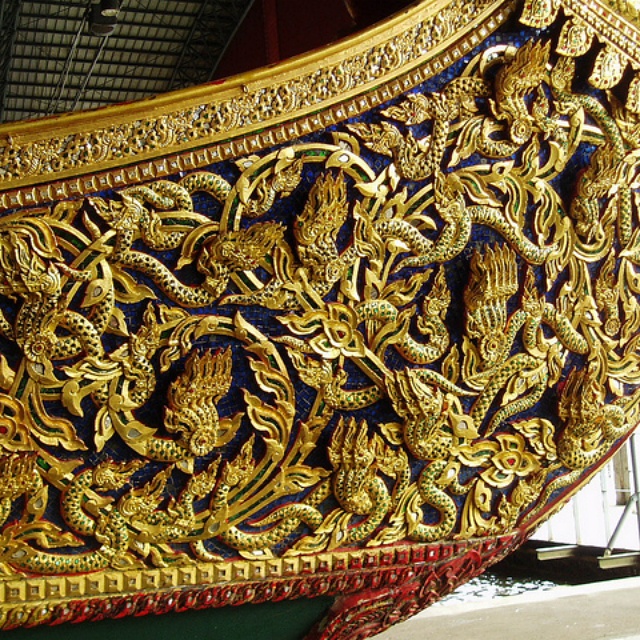
These are just a few of the 52 barges currently in existence. These barges are considered National Treasures and used only in special ceremonies. To date there has been only 17 ceremonial processions in the reign of King Rama IX.
Other barges on display at the museum include the Ekachai Hern How Barge which has a long necked serpent on the bow, the Asura Vayuphak Barge noticeable with a black hull and the figurehead of a indigo colored ogre/bird like face figure and last but not least the Krut Hern Het Barge which depicts a Garuda holding on to a serpent. This barge has gold floral designed motifs with a red interior and black base exterior.
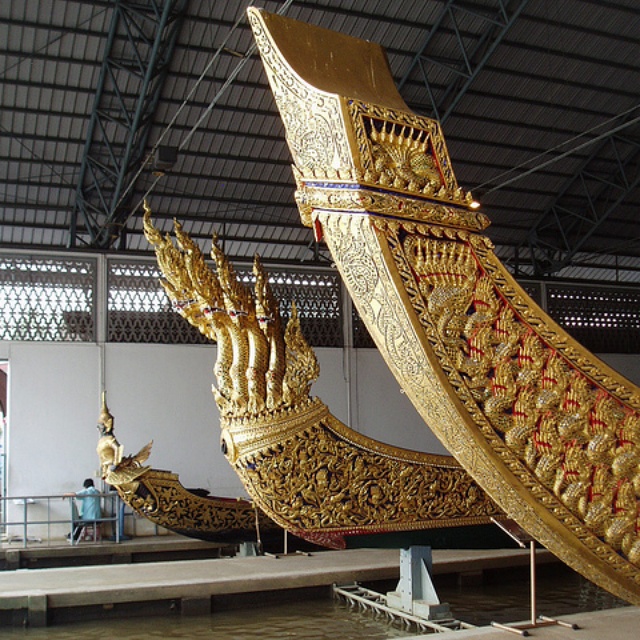
The Royal Barge National Museum is located at 80/1 Arun Amarin Rd., Bangkok Noi, Bangkok, 10700 which is at Khlong Bangkok Noi on the Thonburi side just a short distance away from the Phra Pink Klao Bridge or actually under it near the Naval base. However you cannot cut through to the base to get there instead have to take a 20 minute walk around the base along some old village houses along the river to get to the museum. There are many small signs pointing the way towards the museum if you are going there by foot.
Alternatively you could take the Chao Phraya Express long-tail boat N10 Wang Lang Pier which offers a shorter walk to the museum or join a long-tail boat tour that includes the Royal Barge National Museum as part of the itinerary. The museum is only open on Tuesdays to Thursdays from 9.00 am to 5.00 pm
